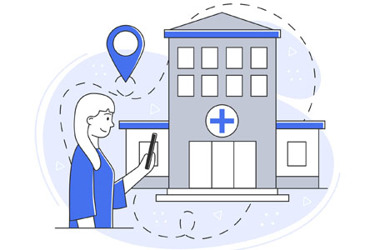How Can Clinical Research Better Navigate Healthcare Deserts?
By Mackenzie Ward and Jordyn Dinwiddie, Halloran Consulting Group

Adequate access to an array of healthcare services is integral to maintaining and improving human health. All aspects of healthcare play an important role in a community’s well-being due to the multifaceted and dynamic nature of health. Despite this, large swaths of the U.S. remain healthcare deserts, where access to services such as pharmacies, primary care providers, hospitals, hospital beds, trauma centers, and low-cost health centers is severely limited.
In 2021, GoodRx reported that more than 80% of counties across the U.S. lack adequate healthcare infrastructure in some shape or form. Additionally, they estimated that 121 million people, accounting for over 37% of the U.S. population, live in a healthcare desert (see the interactive map here).1 These individuals face poorer health outcomes as a result of the glaring lack of equitable healthcare access.
Who Is Affected By Healthcare Deserts?
The vast majority of healthcare deserts in the U.S. are in rural communities. Populations in rural areas tend to experience greater difficulty in accessing adequate healthcare services due to geographical barriers. Residents of rural communities often must travel far greater distances to reach medical centers (42% of patients have reported that transportation is a barrier to participating in clinical trials), as most major medical institutions reside in urban areas. This leads to poorer health outcomes in individuals in rural communities.
In the case of cancer, “rural residents are less likely to get cancer, but they are about 10% more likely to die of the disease than urban residents.”2 This shocking statistic reveals the deep health disparities between rural and urban communities that are reflected across diseases and conditions.
Healthcare Deserts Contribute To Underrepresentation In Clinical Research
The lack of access to healthcare services further harms rural communities by limiting access to clinical research. There is currently an uneven distribution of trial sites relative to the population with most major heath and research institutions clustered in urban areas. Therefore, the burdens associated with clinical trial participation fall disproportionately on those in rural areas. Transportation costs and overall time commitment are vastly greater and, often, rural communities are lower income, have higher rates of uninsurance, and have reduced internet access, thus compounding barriers.
Additionally, individuals in rural communities tend to be less aware of available clinical trial options. The majority of advertising and recruiting for clinical trials are done in the urban areas where clinical sites are typically situated, making it easier for individuals in urban environments to learn about ongoing studies. This lack of exposure also feeds higher distrust and fear in clinical research among rural communities, driving individuals away from any desire to participate.3
While these barriers are difficult to overcome, it is important that continued efforts are made to include rural populations in clinical research. Ideally, clinical trials would be dispersed in an equitable way to maintain scientific integrity, ethical standards, and access to novel treatment options. While the current underrepresentation of rural communities fuels existing health disparities, awareness around this issue is increasing and more clinical trial sponsors are taking the steps to make meaningful changes to conduct clinical trials in a way that is more representative of the entire population and helps facilitate trust in research and medical institutions.
The Important Roles Of Technology And Community Outreach
Conducting clinical trials is difficult even in ideal settings. Adding the complexity of healthcare deserts and the populations that reside in them presents an even greater challenge. Fortunately, many hospitals, providers, and companies are becoming increasingly aware of the issue and are working to develop methods to overcome some of the obstacles to successfully conduct studies in rural areas.
Technological advances have made it possible to conduct study visits remotely, effectively decreasing barriers concerning geographical distance and transportation. Researchers can also leverage technology and shared data to use multiple satellite centers to conduct study visits in more remote areas, rather than relying on urban centers. Decentralized clinical trials are gaining popularity as an alternative to more conventional clinical trials. Bringing clinical trials directly to patients not only increases accessibility for those in rural communities but has also improved patient convenience and experience. Some companies are choosing hybrid clinical trials to reach a wider population pool while also acknowledging the limitations associated with specialized procedures and assessments.
Another step that is being taken to reach rural populations is increased community outreach. Educating individuals on clinical trial options and speaking directly with underrepresented communities increases awareness and improves trust among those who may not have had the same exposure. Each little step goes a long way in creating more opportunities for those living in rural areas.
What Are Some Current Industry Efforts To Address It?
Other industry innovators are utilizing their electronic resources. CVS Health has built a decentralized model to deliver clinical trials using their virtual HealthHub that allows for at-home services.4 They recognized that up to 30% of those who enroll in clinical trials end up dropping out, for reasons including inconvenient trial location.5 Decentralized clinical trials use technology to communicate with study participants and collect data. In some cases, the participant can use their personal cell phone to answer questions or meet virtually with the study staff. This lessens the number of in-person visits and travel, allowing for more geographically diverse patient pools.
The Dartmouth-Hitchcock Medical Center is using a multi-million dollar grant to expand their clinical trial sites to smaller outlets in Maine and New Hampshire. This will allow for treatment access outside of large cities. As rural patients tend to have higher rates of cardiovascular disease, the increased provision of care in these areas has the potential to bring treatment to those in need.
The University of North Carolina’s TraCS Inclusive Science Program is helping to further support clinical research in rural areas through the launch of their Rural Health Research Toolkit. It is free to download and helps to develop protocols and recruitment and retention strategies, as well as guidance to help engage rural communities in the research process.
Another example is the Oregon Community Health Information Network (OCHIN), which was founded in 2000. They created a nonprofit that started as a project to expand healthcare access to all, despite location or race. They have mainly focused on connecting people with primary care resources. They also offer support with regulatory compliance and information on how to conduct pragmatic clinical trials that will not increase the burden on already stressed rural healthcare centers.4
The Ohio State University Comprehensive Cancer Center’s (OSUCCC) Center for Cancer Health Equity (CCHE) has developed an outreach program to contact patients in rural parts of the state. They collaborated with the OSUCCC mobile mammography department to take mammography services to where high-risk women live, rather than waiting for these women to come to them. The program went to nine counties that had no hospital at all. From 2015 to 2019, the program screened over 3,000 women and detected cancer in 32.6
Conclusion
Adequate access to healthcare services is integral to maintaining and improving human health and yet, there are significant pockets of the U.S. that remain healthcare deserts. But as technology continues to offer innovative approaches to clinical research to bring healthcare options to communities in need, we anticipate essential improvements to come that bridge the healthcare gap and fosters trust in clinical research.
References:
- https://assets.ctfassets.net/4f3rgqwzdznj/1XSl43l40KXMQiJUtl0iIq/ad0070ad4534f9b5776bc2c410
91c321/GoodRx_Healthcare_Deserts_White_Paper.pdf - https://healthcare.utah.edu/huntsmancancerinstitute/news/2022/07/bringing-cancer-clinical-trials-to-rural-communities.php
- https://pubmed.ncbi.nlm.nih.gov/24310703/
- https://dcri.org/wp-content/uploads/2021/11/Addressing-Clinical-Trial-Deserts-Executive-Summary.pdf
- https://www.cvshealth.com/news/clinical-trial-services/cvs-health-introduces-clinical-trial-services.html
- https://ascopubs.org/doi/full/10.1200/OP.20.00174
 About The Authors
About The Authors
Mackenzie Ward is a consultant at Halloran Consulting Group. Before joining Halloran, she worked in the CRO space. She has a patient-focused perspective and is passionate about bringing treatment options to underserved populations.
 Jordyn Dinwiddie is a consultant at Halloran Consulting Group. Before joining Halloran, she worked for the New Mexico Department of Health coordinating the electronic delivery of notifiable conditions from hospitals and laboratories.
Jordyn Dinwiddie is a consultant at Halloran Consulting Group. Before joining Halloran, she worked for the New Mexico Department of Health coordinating the electronic delivery of notifiable conditions from hospitals and laboratories.
